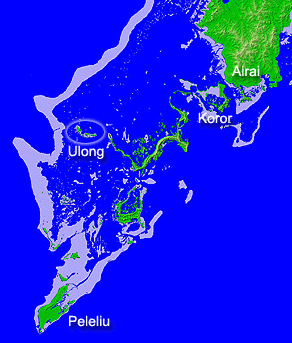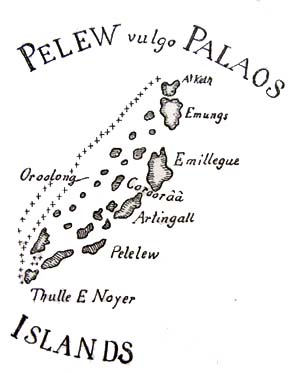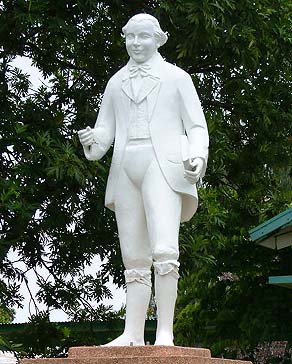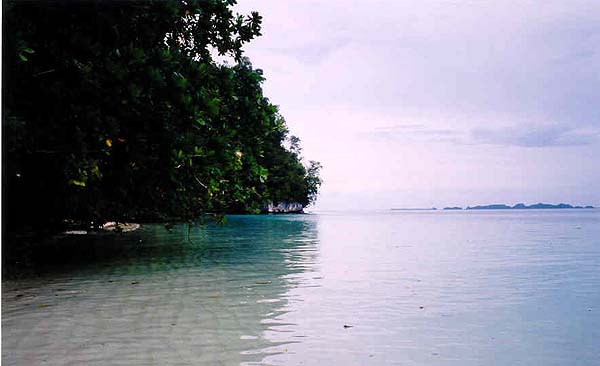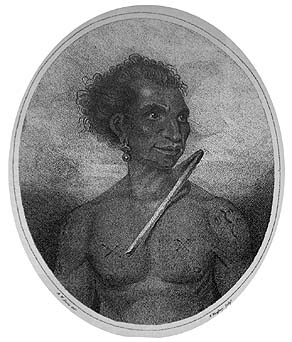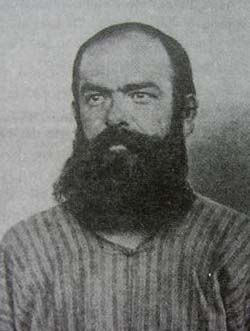 |
 |
 |
 |
||||
|
|
|
|
|
|
|
|
|
|
|
|||||||
|
|
|
|
|
|
"In Palauan history, the first contact with the West would actually be around 1500," Kathy explains. "They say that Magellan came through here, though I don’t know if that is correct." There is some indication that one of this ships spotted Sonsorol, far to the Southwest of the main islands. "But the first Western person to sight the islands of Palau was 1579. That was Sir Frances Drake. But since that time it was sporadic and by chance: either the ship got blown off course, or they just happened to be passing by and they saw islands and they stopped by. It wasn’t part of their itinerary."
|
||
|
|
||
"But Captain Henry Wilson was an exceptional man and he was of very high society. He was a gentleman of the highest order. He treated the natives very, very kindly. And throughout this, guns were exchanged, the Palauans had a taste of cigarettes and smoking, and taste of the whiskey. And the Palauans in turn exchanged bananas and brought food and all of that, so there was this kind of good social exchange between them."
|
||
|
|
||
“His first agenda was to get his ship repaired and then go back to England and report what he found; and then continue his voyage, which was commissioned by the Queen to explore this area, to lay claims to some of the islands and the lucrative spice trade that was going on in this area. "So after six months, they finally got the ship together: they cut the lumber here and took whatever they could from the ship and rebuilt the Antelope. The name of the ship was the Antelope, and it sailed back to Macau. "When they went back, they took Leeboo, who was the son of the Ibedul, the high chief of Koror. And they took him to England, but he died of smallpox there. So that’s the most extensive western contact that we had with the islands."
|
|
|
“When the ship was finished,” Johnson adds, “they drew on the side three circles, on inside each other, one circle and then the bigger one, so they were three circles, one within each one. The Palauans drew this for them. "Then they brought the Palauan magicians to do their thing on the ship. Initially when the boat came in, it was an East Indian vessel called Antelope. After it was shipwrecked, they used their salvageable materials and local wood to build a new, smaller boat, and Captain Wilson named it Redeemer. "But the Koror chief said, ‘change the name to Oorolong,' because Ulong is the island where they lived in the Rock Islands. Oorolong is the corrupted spelling of Ulong."
|
|
|
|
|
“In return for the chief’s kindness," Kathy continues, "Captain Henry Wilson took his son back to England. The chief wanted his son to be educated and to learn the new things. The British were demonstrating the guns, and the natives—once the guns were fired—they ran and went into the bushes because they were afraid of the sound and the magnitude of the whole thing. But when they learned that this can do damage to….
|
||
|
|
||
“The British helped Chief Ibedul, because Palau at that time was fighting with one another. There was warfare and village rivalries, and when Captain Wilson came, there were already two federations: the Western federation which High Chief Ibedul controlled, and the Northern federation which High Chief Reklai controlled, and they were constantly at odds. There were little wars raging between the villages, and beheadings and violence. "When Captain Henry Wilson came, he helped to elevate Chief Ibedul to kept control. Captain Wilson helped him conquer Melekeok, which they did. What they did is they put a cannon on this huge canoe, on one of the war canoe, and went to Melekeok. And they didn’t really kill anybody with that gun. All they did was put some powder into it and let it blow, and everybody ran off to the bushes."
|
|
|
"That’s the reason the Ibedul got elevated to the rank where he is right now. It did not unite Palau. It just temporarily held it for a while, until other whalers and traders came. "The rest of Palau, knowing the story of Captain Henry Wilson, wanted to get any foreigner, any outsider they could get hold of. Palauans were in this competitive warfare between each other, with Western men in the middle of the whole thing. "And any village that could claim some association with a Westerner was really something, because then they could get guns and knives and so forth."
|
“The trading and whaling ships that came through did not stop here often, so it could take years before a ship would pass by. There was Captain Wooding and then Captain O’Keefe who traded, who really explored the coconut and trepang business between Yap and Palau, and so expanded the trading. "Then also came anthropologists. Kubary came in 1871: he was a scientist, a botanist, but he also recorded a lot of social observations. "So there were these visitors coming in and out of Palau during that time. Very few stayed. There were some intermarriages. There are some descendants of some of these whalers and traders from that era, up to the time before the Spanish American War."
|
|
|
|
|
"Then Spaniards actually came and claimed the area for Spain, and started trying to spread Catholicism." And that takes us to a discussion of missionaries.
|
||
|
|
||
|
|
|
|
|
|

|
| Airai Home | Map Library | Site Map | Pacific Worlds Home |
|
|
|
|

|
|
|
|||
| Copyright 2003 Pacific Worlds & Associates • Usage Policy • Webmaster |
|||


